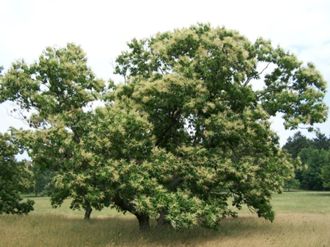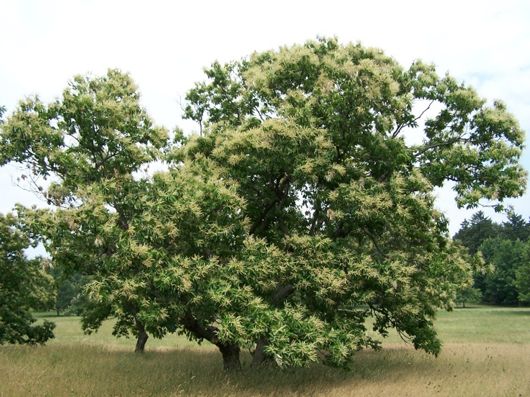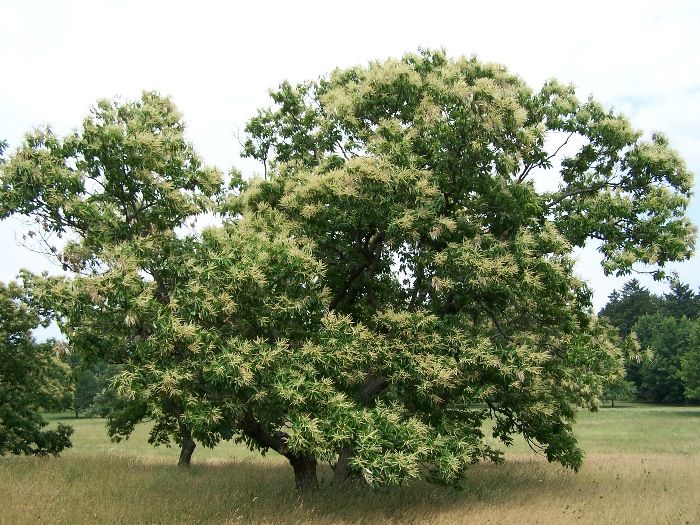The Solution for Chestnut Decline


The American chestnut tree was one of the most important trees in the Eastern U.S. but by the end of the 1930s, blight caused detrimental chestnut decline.
The American chestnut tree (Castanea dentata) used to be one of the most common — and important — trees in the Eastern half of the country. So, what happened to them?

Chestnut Blight: A Devastating Fungal Disease.
Chestnut decline, attributed to blight, is caused by an Asian bark fungus (Cryphonectria parasitica), which was unknowingly imported from Asia on infected Chinese Chestnut trees. While the Chinese variety adapted and developed a sturdy resistance to the blight, the American chestnut was no match for it.
The disease was first documented in 1904 on trees in the Bronx Zoo. The airborne blight was spread by downward winds. It spread 50 miles a year, and, within a few decades, had killed nearly three billion chestnut trees. It particularly devastated trees in the Appalachian region, where up to 25% of the trees were American Chestnuts. The spread of the blight resulted in billions in crop and lumber losses, as well as a decline in wildlife populations that fed off the nuts.
Mistakes were made in attempting to manage the blight; loggers destroyed resistant trees in an effort to stop the blight spread, depriving them of the chance to reproduce healthy stock. "Devastation" is not an overstatement: today, the number of American Chestnuts trees east of the Mississippi with a diameter larger than two feet is now less than 100.
Hot, humid weather is required for the blight to take hold. The disease is recognizable by its bark lesions, which eventually girdle the trunk and kill the tree. New shoots will sprout from the roots when the main trunk dies, but the shoots rarely grow more than 20 feet high before the blight comes back again.
You can still find scattered stands of healthy American Chestnuts in places where the climate is cooler, like the Pacific Northwest, British Columbia and the northern area of Michigan’s lower peninsula. At present, it is believed that survival of C. dentata for more than a decade in its native Eastern U. S. range is almost impossible. The fungus likes Northern red oak as a host, and while the oak ignores it, any nearby American Chestnuts will quickly attract it.

So can anything be done to save them?
Several organizations are actually trying to breed the blight out of existence. In 2009, The American Chestnut Foundation (ACF) began planting hybrid trees that naturally back-crossed the blight-resistant Chinese Chestnut into American Chestnut. One of these hybrids, with 2% Chinese Chestnut DNA, was planted on the White House lawn several years ago. It is still healthy. Stark Bro’s now offers several hybrid chestnut trees to enjoy in your landscape without risk of contracting chestnut blight.
If you've got sick American Chestnuts of your own, there may be some hope. According to Penn State's College of Agricultural Sciences, these methods are showing some success:
- Soil Compress Method: (also called "mudpacking") Dr. Wayne Weidlich, an ACF Director, has noted that by packing soil over trunk cankers, the blight might “suffocate.” It apparently works, but only for trees under 40 feet tall. It is also not a preventive treatment, but can address individual cankers which might otherwise kill the trunk. The method: make a black plastic sleeve to fit around the trunk, secure it with weatherproof tape, fill with at least two inches of moist soil, and leave in place for two months. Add water at the top once or twice if it dries out.
- Chemical Control: Recent success has been had with the use of Agrifos (phosphorous acid) and Pentrabark (a systemic surfactant) to treat chestnut blight. While a chemical treatment would certainly be impractical in a forest, it could be used to treat a small number of trees in a residential setting, as elm trees are injected with chemical solutions to treat Dutch Elm disease. Do not attempt this yourself; contact a licensed tree professional who is legally authorized to handle the strong chemicals used to treat the trees, which will require an annual application.
- Hypovirulence: In the experimental stage is a method called hypovirulence, which essentially gives the fungus a virus which kills it. Right now there are no commercially available preparations of the virus. See the archives at The American Chestnut Foundation for more information on hypovirulence.

Significant efforts are underway to replant the chestnut on a large scale, not only for its heritage and beauty, but for its economic value. In its heyday, the American Chestnut was a critical element of eastern rural economies and an important cash crop for many Appalachian residents. The bark, loaded with tannic acid, was used for leather tanning. American Chestnuts are cold-hardy, rot-resistant, fast-growing and strong for their weight, reaching up to 100 feet tall and ten feet across, making them a valuable timber commodity.
The diligence of organizations like the ACF are hoping their efforts will restore not only the species, but the livelihoods of so many whose lives were destroyed by blight and chestnut decline.
- Article Categories:
- Ideas & Inspiration











































